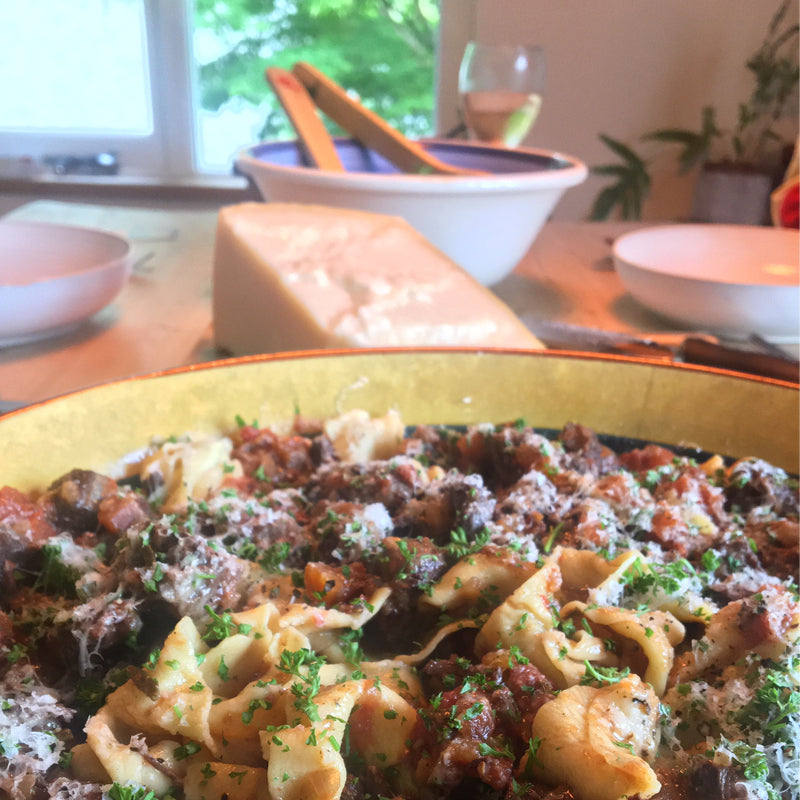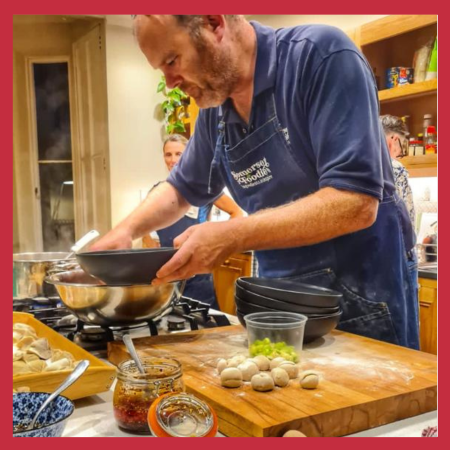Slow Cooked Shin of Beef and Fresh Tagliatelle
Slow cooked shin of beef and fresh tagliatelle
There is something primal about making your own pasta, a bit like making your own bread. I don’t always have time to do this (or the organisational ability), but when I do, I like to make it special.
Tom and Charlotte Wheeler are local farmers that live really close to Somerset Foodie in Norton St Philip. Every so often they send a shout out for fresh home-reared beef. I’m a real fan of the lesser cuts, the ones that you have to slow cook - you end up with intense beef with real ‘umami’ flavours. This recipe is a bit like Spaghetti Bolognese on steroids, it’s really the same principal but you just need more time to end up with a dish that’s truly memorable.
For the Slow cooked Skin of Beef - Serves 4
1kg Beef Shin (Best on the bone, Italians call this Osso Bucco, but no probs if it’s already diced)
2 x White Onions, Peeled and finely chopped
3 x Carrots, peeled and diced
3 x Sticks of celery, diced
6 x Cloves of Garlic, roughly chopped up
1 x Good sized bunch of rosemary, chopped
1 x Bay leaf
1 x Star Anise (Optional, but really helps to get that umami beef flavour)
2 x 400g canned tomatoes - we sell these, buy the BEST you can find.
500ml Beef Stock (I use a good quality dried stock)
2/3 of a Bottle of Chianti (Any red wine will do, but Chianti is great)
Sea Salt
Fresh Parsley, finely chopped
Fresh Parmesan or Grana Padano for grating
Rapeseed Oil for Cooking - we use Fussels oils which are grown here on the farm in Rode village.
Extra Virgin Olive Oil for drizzling at the end
Seasoning is so important in this recipe, if you can, season your beef for at least 2 or 3 hours before you come to cook it – it just helps to the get the seasoning right into the meat. The other important bit is to get lots of colour on the meat – there is plenty of science going on here, but to put it simply, it rearranges certain amino acids and simple sugars during the browning process. This effectively creates lots of additional layers of flavour, giving you real depth in your cooking. So start by getting your pot nice and hot, add a little rapeseed oil and brown the meat all over, being careful not to over crowd the pan - do this in several batches if you don’t have a massive pot.
Once the meat is browned all over, remove it all from the pot and set aside. Turn the heat down now and add the onion, carrots and celery and sweat down for 5-10 minutes, until the onion just starts to caramelise a little (again, more flavour enhancing). Add the garlic, rosemary, bay leaf and star anise and cook for a couple more minutes.
Now add the Chianti into the pot, turn the heat up and give it a quick bubble. Turning the heat back down again, put the beef back into the pot and combine with all the vegetables and add the cans of chopped tomatoes. The tomatoes introduce an element of acid into the dish which contrasts with the other flavours, helping you to achieve that elusive umami flavour. Finally, pour over the beef stock, bring everything up to a simmer, whack a heavy lid on and shove it in a low oven. I go for something around 150-160°C. Leave it in there for around 3 hours (whilst you make the pasta) but try to take it out at least an hour and half before eating, this is because you now want to finish cooking on the top of the stove with the lid off – gentle reducing down the liquid to really intensify the flavours.
To make Fresh Pasta
Serves 4
300g 00 Matthews Pasta Flour
2 x Large Eggs
3 x additional Egg Yolks
Semolina Flour or Pasta Flour, for dusting
Making fresh pasta really is very simple and you don’t need a pasta making machine, just a good solid surface and a rolling pin will do. 00 grade flour will be the best flour to use if you’re a novice; I use our Matthews 00 Pasta flour which is milled in the Cotswolds using carefully selected Italian wheats. I find that resting the dough for a good 2-3 hours gives the best results and allows for the gluten in the dough to relax enough, losing any elasticity that will make it hard to work with.
You can use a mixing bowl if you like, I just pour the flour out onto my surface and make a well in the middle. Crack the eggs and the additional yolks into the well and beat them with a fork, mixing in a little flour from the sides as you go. Eventually you will end up with a shaggy mess on the board, but don’t worry, keep working it and will all come together in one lump. Use an extra egg yolk or a little splash of water if you’re struggling.
Here's a short video of me making fresh pasta with 11 year old friend Max, which you might find helpful and reassuring if you're doing this for the first time.
Using the heel of your hand, start kneading the dough – you’ll need to do this for about 5 minutes. The dough should become uniform in colour and smooth on the surface. That’s it, dough made. Now wrap in cling film and leave and room temperature for at least an hour, 2 to 4 hours is preferable.
So now we have our pasta dough made and our shin of beef gently simmering away of the stove (having taken it out of the oven after 3 hours).
Get the biggest pot you have to cook the pasta, it’s really important to cook it in plenty of water but also make sure you put plenty of salt in the water. The pasta will only be in there for about a minute, so salt the water well – so you can detect saltiness in the water if you taste it.
On a floured surface, roll out the pasta – I use a rolling pin, just like Nonna used to do (I lie, my granny never made pasta, she was from Scotland!), but if you have a pasta roller, use that. It’s best not to attempt to roll out all the dough in one go, unless you have a massive rolling pin and a huge board – roll it out in 2 or 3 batches. The key is to get it nice and thin and even and aim for something that's vaguely rectangular.
To cut the pasta, dust the sheet with some semolina flour and fold the dough over from the top into roughly 1 inch folds, adding a bit more semolina flour it necessary – you’ll end up with something that looks like a long, flat sausage. You simply then take a sharp knife and cut the sausage into slices, about a half inch thick – that’s your preference, but you will either be making Fettuccine, Tagliatelle or Pappardelle. At the end of the day, who cares, you’ve just made your own fresh pasta! Fluff each cut piece up so it unrolls and gets a little dusting of semolina flour to stop it sticking, place on a tray and cover until you’re ready to go.
Now you’re on the final stage, if you’re happy the liquid in the beef has reduced enough (it doesn’t want to look like there’s loads of gravy in the pot) remove it from the heat and place it into your serving dish. Make sure the water in your pot is boiling vigorously and add the pasta – it takes literally a minute, so keep tasting it as it you really don’t want to overcook it. When there is still a good bite to it, remove it from the pan – I just do this with some tongs and drop it straight in with the beef. Mix the beef and pasta together and grate plenty of parmesan cheese over – this is the final element to bring together your umami flavours. Scatter over the chopped parsley and drizzle over a little extra virgin olive oil.
Bravo, it’s done. Crack open an bottle of chianti and get stuck in.
Ben Tollworthy, Somerset Foodie.









2 Comments
This is now a go to Sunday Dish for us. Absolutely delicious. I don’t always make my own pasta but the kids have really enjoyed doing that with me some weekends.
That is so deliciously written I am going to have to make it this weekend….. will report back! x